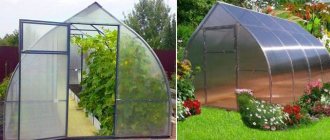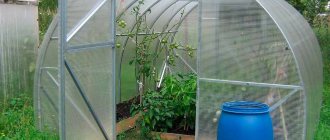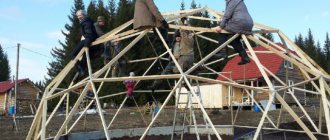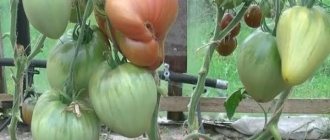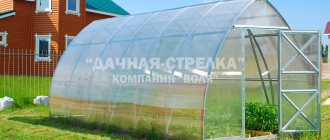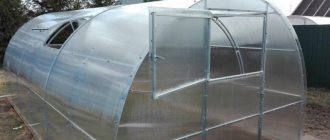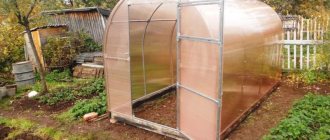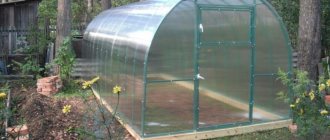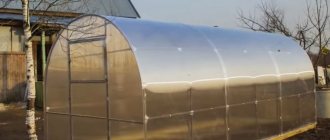Despite the abundance of existing types of greenhouses, the choice of greenhouse should be approached with special care, because even the slightest violation in the design features can have an extremely negative impact on its thermal insulation properties.
Any structure of this kind must meet quality requirements and be made only from approved materials. One of the highest quality and most noteworthy types of greenhouse structures is the “Droplet” - a reinforced greenhouse that can withstand any weather conditions.
Description and characteristics
The main design features of “Kaplya” greenhouses are as follows.
- teardrop shape
This design solution does not allow snow to accumulate on the surface of the greenhouse, and also increases the stability of the structure even with very strong gusts of wind.
- Reinforced frame design
The frame is formed by profiled pipes with a rectangular cross-section of 20x40 or 20x20 mm and a wall thickness of 2 mm. All arcs are fastened with reinforced transverse elements, which allows the greenhouse to withstand significant loads.
- Anti-corrosion coating of main parts and fasteners
Coating the frame with a special composition guarantees protection against rust formation and significantly extends the service life of the structure.
- Complete with high quality polycarbonate sheets
This material is protected from the destructive effects of UV rays and does not form fragments even when the strength threshold is exceeded. In this case, the entire greenhouse is covered with polycarbonate, due to which every centimeter of usable area inside the greenhouse receives the required amount of light.
Novator and other drop-shaped greenhouse models
If you purchase a greenhouse from another manufacturer, the shape of the polycarbonate roof will be similar. But the basic parameters will be slightly different. For example, here is a description of the Novator Droplet greenhouse (TSK Empire):
- width - 3 m;
- height - 2 m;
- length - from 4 to 12 m, in increments of 2 m;
- the gap between the arcs coated with an anti-corrosion compound is 0.66 cm;
- polycarbonate thickness - from 3 to 6.5 mm;
- You can install additional partitions inside to divide the space into 2 parts;
- pipe diameter - from 20x20 mm in the arch to 30/40x20 mm at the base;
- The frame is placed in the ground on stakes.
A luxury option is possible, using not Russian, but Austrian polycarbonate. Such sheets have a special protective coating against ultraviolet radiation. Additional accessories can be purchased for an additional fee. For example, a roof vent or a ventilation machine.
There are also other models in the shape of a pointed arch. These include the drop-shaped greenhouse Tsarskaya Strelka (Mosteplitsa). Its length is from 4 to 10 m. The height of all products is the same: 2.2 m. Width - 2 m, 2.7 m, 3 m, 3.5 m. Polycarbonate sheets also have different parameters.
Attention! The price of teardrop-shaped greenhouses depends on their dimensions, thickness and quality of polycarbonate and other factors. The minimum cost of a small greenhouse 4 m long is 15-16 thousand rubles. (Innovator-Droplet).
Advantages and disadvantages
Which polycarbonate greenhouse is better: “Droplet” or arched?
Compared to other types of greenhouses, “Kaplya” has the following advantages:
- pointed shape that prevents snow from lingering on the structure;
- impressive dimensions allowing you to carry out work in comfort;
- long service life (from 5 years even in harsh climatic conditions);
- the possibility of increasing the length of the greenhouse through the use of special inserts.
In addition, “Kapelka” retains heat well, and the presence of doors and windows has a beneficial effect on ensuring proper air exchange and, as a result, creating a microclimate suitable for plants.
The drop shape allows you to increase the height of the greenhouse to 2.39 meters, which provides additional free space under the ceiling for hot air in hot weather. At the same time, the tallest arched greenhouse can only reach 2.1 meters.
The higher the distance between the roof and the top of the shoot (the so-called buffer zone), the more favorable the thermal regime for plants.
The disadvantages include:
- installation is quite difficult, but you can still assemble such a greenhouse yourself, without turning to specialists for help;
- high cost, so prices for such greenhouses are slightly higher than for arched ones;
- the need to plant tall crops closer to the center.
It should also be noted that there is a weak spot – the ridge. If it is not covered with a galvanized profile, then rainwater will fall directly into the polycarbonate honeycomb.
Which greenhouse to choose: an arch or a drop?
Gardeners' sympathies for arched greenhouses and gable greenhouses in the form of a house are divided approximately equally. With identical components, the models have a comparable set of pros and cons.
But the Droplet greenhouse in the form of a pointed arch, although similar to the arched one, is significantly different. Let's understand the advantages and disadvantages of these two types.
Advantages of an arched greenhouse
The arched shape resists wind and snow loads well. The design consists of a small number of parts and is quickly assembled. An arch made of cellular polycarbonate is characterized by high illumination parameters - plants evenly receive direct and diffused light throughout the day.
Polycarbonate bent into a hemisphere serves not only as a coating for the structure, but also as a frame, giving additional rigidity.
The shape of the arch creates a significant internal volume - even with a minimal base area there is enough air inside, it is easier to breathe.
Disadvantages of an arched greenhouse
Difficulties in arranging ventilation. The basic configuration includes vents in the doors for ventilation. This is not enough for hot weather, so you have to open the doors.
However, for many vegetable crops, such ventilation is a stress – “the head is hot, the feet are cold.” A draft removes moisture from the soil, which disrupts its structure and requires watering more often.
Windows on the side walls help to improve the removal of overheated air - they can be ordered additionally. If you install it yourself, it is not easy to achieve the desired tightness.
Sloping side walls reduce the number of seats for tall crops; they have to be located closer to the center.
Resistance to snow loads increases with an increase in the cross-section of the profile arches of the frame, the number of longitudinal ties, and with a decrease in the pitch between the arches. The basic economy model will require additional attention during operation.
Droplet greenhouse: advantages and disadvantages
A greenhouse resembling a drop, a modification of an arched structure. And it has all its advantages.
Architects call the shape a pointed arch - two semicircular arcs intersect at some angle. Therefore, the model is produced under different names: “Droplet”, “Strelka”.
The main advantage of the droplet greenhouse
It is the “Droplet” with a steep slope that is chosen by residents of northern regions with frequent snowfalls and winds. The super-strong design with the highest class of resistance to wind and snow loads can be considered a breakthrough in the greenhouse business.
A correctly calculated pointed arch has the same resistance to deformation as a classic arched structure, but the upward-extended shape does not retain snow. It rolls better under its own weight, like a gable greenhouse.
Durable frame
The pressure on the walls of snow falling on the sides is resisted by 6 or 8 horizontal metal ties and the arcs themselves with a profile cross-section of 25x25x1.2 mm. The probability of deformation tends to zero.
Installation features
Each product must be accompanied by instructions for assembling the “Droplet” greenhouse from the factory (manufacturer). Typically, the sequence of actions is as follows.
- Construction of the foundation.
- Make a marking, remove the top part of the soil along it, compact the soil at the location of the greenhouse. Lay a layer of geotextile and create a sand and gravel cushion.
- Install a foundation in the form of a frame using 10x10 cm timber. If it is necessary to obtain a more reliable foundation, pour concrete using formwork.
- Assembling the frame in accordance with the included instructions.
- Using self-tapping screws, fasten all the arcs and parts of the end module to the door. Attach it to the foundation frame.
- Assemble additional modules with a window and attach them one by one to the base.
- Assemble and install the last end module and also attach it to the foundation.
- Fasten all parts of the frame together.
- Laying polycarbonate . Lay the sheets in a vertical direction, bending them if necessary at the locations of the stiffeners. Apply special tape to the panel ends and cover with a profile.
You can follow the following videos for instructions on assembling a “Droplet” greenhouse made of polycarbonate with your own hands.
Recommendations for using a greenhouse
In order for the greenhouse you purchased to last a long time, you must:
- Entrust the assembly of the entire structure to specialists or those craftsmen who have already dealt with the installation of such structures. A prerequisite is to carry out the assembly strictly according to the instructions provided by the manufacturer. This is a guarantee of high quality.
- It is recommended to periodically clean the polycarbonate coating from dirt and dust . To do this, it is better to use a large volume of water (preferably soapy), soft rags or sponges. No hard brushes or other abrasive tools . They will simply ruin the polycarbonate, and the sun’s rays will begin to penetrate into the damaged areas. And under their negative influence, the transparent coating will immediately begin to collapse.
- Keep in mind that the maximum snow load that the Droplet greenhouse structure can withstand is 290 kg/m². That is, if a snowfall has piled a thick layer of snow on the greenhouse, which for some reason lingers on the roof of the structure, then you should not wait for it to roll off on its own. Get to work - remove the snow cover yourself.
- Be sure to periodically check the connections of the greenhouse parts and assemblies . If necessary, tighten the bolts.
Greenhouse care
Caring for “Droplet” does not take much time and effort.
Shading should be done by spraying the surfaces of the greenhouse with ordinary chalk.
In autumn from the greenhouse you need:
- remove plant debris;
- carry out soil treatment;
- disinfect the structure;
- preserve the greenhouse for the winter.
Thanks to the pointed shape of the “Drops”, there is no need to clear snow from it in winter - it will roll off the surface without loading the structure with its own weight.
Photos of drop-shaped greenhouses
The Droplet greenhouse does not shine with variety. However, its characteristic shape is quite attractive, so this design at the dacha looks very aesthetically pleasing both in the yard and in the garden. In addition, when decorating, you can use transparent and colored polycarbonate.
Customer Reviews
Judging by customer reviews, the Droplet greenhouse has a number of undeniable structural advantages. At the same time, experienced gardeners recommend installing the frame on a prepared foundation, and the wooden beam is subject to destruction, so it is best to make the foundation from concrete or brickwork.
Greenhouses of this type are most popular in regions subject to heavy snowfalls. According to them, “Kaplya” withstands the tests not only of snow, but also of strong gusts of wind.
Thus, “Kapelka” polycarbonate greenhouses are an excellent option for those who value functionality and reliability in greenhouse structures.
Greenhouse strength
This technical characteristic of any greenhouse is the most important. And since our story concerns the “Droplet,” we will try to explain why both consumers and experts consider this greenhouse to be one of the most durable. But before moving on to the analysis of the heroine of our article, I would like to dwell a little on what criteria make up the strength of a greenhouse.
- First of all, strength is affected by the shape of the structure . This takes into account snow cover , which is the main load on greenhouses. Therefore, the steeper the roof of the greenhouse, the easier the snow slides off it. Arched greenhouse structures are very popular among summer residents . But it should be noted that there are other forms that fit this criterion. First of all, these are structures with gable roofs , which have a fairly large angle of inclination. There are forms that are called arched-lancet . By the way, this is exactly what “ Kapelka ” has.
Arched greenhouse Source teplica02.ru
- The second criterion is the thickness the polycarbonate used . , 4 mm thick polycarbonate is used to cover greenhouses and greenhouses . But in regions where snow falls in large quantities , it is recommended to choose greenhouse structures covered with polycarbonate with a thickness of 1–6 mm . Experienced summer residents assure that you can save on this size indicator by constantly clearing greenhouse structures of snow. But it's better not to take risks. Let us add that it is necessary to pay attention to the density of polycarbonate . The bigger it is, the better.
The optimal thickness of polycarbonate is 6 mm Source oldi-stroy.ru
- Type of frame. That is, it can be one-piece or collapsible, standard or reinforced. The advice here is that it is better to choose a reinforced collapsible structure. It is easier to transport, because for the one-piece version you will have to order a truck for transportation. Although the latter is stronger than the collapsible one. But if you choose the enhanced version of the second, then the problem is solved by itself.
The frame of the “Droplet” greenhouse is collapsible Source dom.ngs24.ru
- An important criterion is the strength characteristics of the parts and assemblies from which the “Drop” greenhouse is constructed. In this regard, it is better to choose those models whose parts are made from a profile with thick walls .
- The closer the parts and components are located to each other, the stronger the greenhouse.
So, we have analyzed all the criteria that must be taken into account when choosing a greenhouse or greenhouse, taking into account its strength characteristics. That is, if the design you choose corresponds to what was written above, then this is a guarantee that the greenhouse will last a long time without creating problems.
See also: Catalog of companies that specialize in the installation of metal structures.
Which greenhouse is better: Drop or arched
In fact, the Droplet is an improved version of the arched design. They have fewer joints of covering material, therefore, the owner will not need to spend additional money and time on sealing the joints. In addition, the shape of such buildings prevents the accumulation of snow outside and condensation inside the room.
Accordingly, if you live in a region with snowy winters, you can choose any of the greenhouses listed above. The only drawback of the Droplet greenhouse in comparison with the arched one is that the internal space in it is smaller.
In the video you will find detailed instructions for assembling it yourself.
Frame material
There are two main options: metal profile or metal pipe . There is also a “farm”. But more on that another time.
The first one is lightweight and cheaper. Many novice gardeners who have never had experience with greenhouses choose just such a frame to begin with. It can be covered with polycarbonate or even regular spunbond. To prevent it from being torn off by the wind, it is advisable to tighten the spunbond to the frame with twine. It “fits” very conveniently into the groove of the profile and is tied to the ground on each side of the arc.
The disadvantage of a metal profile can be considered the lightness and low reliability of the structure. In sunny, windless weather, such a greenhouse will really seem like a good option. But as soon as the wind blows... We already had the pleasure of calling technical service when our Hacienda greenhouse was torn out of the ground by a strong wind and thrown over electrical wires.
Little of. When it snows, a whole snowdrift can form at the top of the greenhouse. If urgent measures are not taken, its mass can push through the roof of your greenhouse. It’s good if you live in a country house and the greenhouse is on the property. You can just go out and shake off the snow. What if your dacha is located a hundred kilometers from your city apartment? After every snowfall you can't run over.
This is partly why we filmed spunbond at our parents’ dacha. Even a thicker polycarbonate coating would not have saved the situation. You would have to put supports inside and hope that they would be enough to withstand the snow load.
Otherwise, we risk seeing the following picture in the spring:
There are two options here. Either constantly throw snow off the roof of the greenhouse, or go to plan “B” - choose a frame made of steel pipes.
This frame costs more, but also lasts longer. The greenhouse will be more resistant to snow and wind loads. The cross-section of the pipe should not be square 20x20mm (as in the picture), but larger 25x25 or even rectangular - 20x40mm. This design will be more durable.
It is especially worth paying attention to how many parts the arcs consist of. Ideally, they should be one-piece and have no welded joints.
It's a good idea to come to the supplier's office with a caliper and ask to see samples of metal pipes. If the metal thickness is less than 1.2 mm, you should refuse the purchase. Such a greenhouse will not last long.
It is worth keeping in mind that metal pipes can be susceptible to corrosion, so it is worth taking some measures to protect them. For example, it will be enough to simply paint them. If you choose galvanized pipes, it will be even better.

